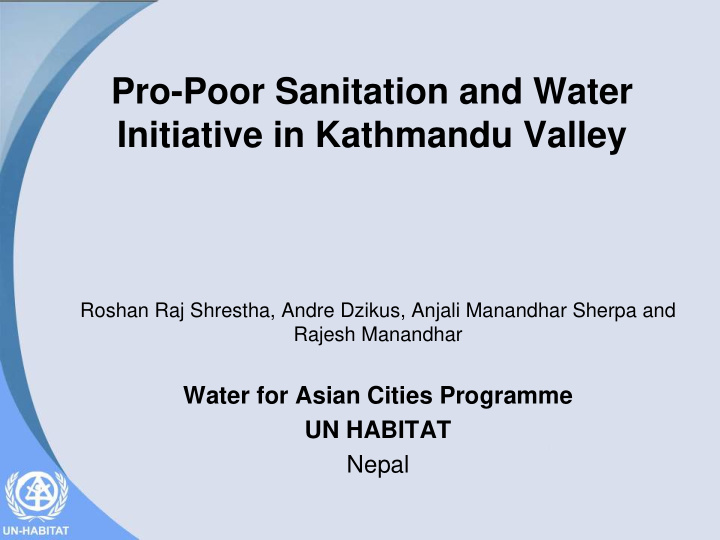



Pro-Poor Sanitation and Water Initiative in Kathmandu Valley Roshan Raj Shrestha, Andre Dzikus, Anjali Manandhar Sherpa and Rajesh Manandhar Water for Asian Cities Programme UN HABITAT Nepal
Water for Asian Cities Programme • A collaborative initiative between UN-HABITAT, Asian Development Bank and the Governments of Asia which was launched at the 3rd World Water Forum in March 2003 aims at capacity building and creating the enabling environment for promoting pro-poor investment in water and sanitation to support Millennium Development Goals.
WAC Programme Countries
Integrated Water and Environmental Sanitation Programme in Peri-urban community in Kathmandu Valley • Traditional settlement 6 kms south east of Kathmandu • Approx. 7000 inhabitants • 52 stand posts serve untreated water from polluted River. • About 40% have toilets • Four women’s open toilet space
Programme Objectives • Demonstrate how a community can work with water supply entity to acquire safe water and adequate sanitation that meet its needs • Demonstration of pro-poor connection charges and tariffs • Increase community awareness on environmental sanitation • Creation of job opportunity for poorest of the poor • Enhance capacity of the local authority, WATSAN Users Committee and the community
Multi-stakeholder Fora Department of Water Supply and Sewerage GoN Regulatory Policy and framework Water and Sanitation Improvement District Development Programme Donor agencies: Committee Facilitation Financial UN HABITAT Siddhipur WATSAN Village Development Financial support Water Aid Nepal Users’ Committee Committee Facilitation Technical Support UN HABITAT NGOs: ENPHO, CIUD
Mapping the poor Mapping the Poor Gender Assessment Survey, FGD, Secondary information I ntegration of Data and I nformation Develop Draft Water and Sanitation Programme I nitial Environmental Examination Final Water and Sanitation Programme
Water Supply System Intake Transmission line 3.3 km Tube settler : 6x3 m = 2.5km pipes Slow sand filter 3 units (each 6.6x12m) Chlorination unit Q :10lps Reservoir : 250 m3 Overhead tank : 50 m3 Distribution network : 9 km Public and private taps 1000 Total Cost : USD 2.15 million (USD30/pe)
Pro-Poor Tariff & Approach for Sustainability • Tariff based on principles of sustainability, affordability, equity and water conservation – Private Taps 2.4 2.7 100 • Up to 7 m3 : Rs. 75 (USD 1.1) 90 • 7 to 10 m3 : Rs. 12 /m 3 80 37.8 • 10 to 15 m3 : Rs. 15/m 3 41.6 70 Rs. 20/m 3 • > 15 m3 : 60 Percent 1.5 1.3 – Community Tap (5 to 10 HHs) 50 • Up to 6 m3 : Rs. 50 40 20.8 20.8 54.1 Rs. 10 /m 3 • 6 to 10 m3 : 30 51.7 • > 10 m3 : Rs. 20/m 3 20 26.7 25.0 10 5.7 4.0 2.3 1.7 0 Household Total Male Female population Extremely poor Very poor Least poor Non poor
Sanitation Improvement • Promotion of on site systems such as Ecological Sanitation, Communal Toilets, Improved pit latrines and Septic Tanks • Community Led Total Sanitation Campaign • Rehabilitation and Improvement of Drainage • Introduction of Fecal Sludge Management System • Household composting & recycling for SWM
CLTS approach Calculation of the amount of feaces entering a person’s mouth: Eg. a leg of a housefly carries 0.001kg or 1 gm of feaces. Assume a housefly sits on a meal three times a day, than the total amount of feaces entering that persons mouth can be calculated as: 1g X 6 legs X 3 times a day X 300 days in a year = 5kg ).
Community Commitment to Stop Open Defecation
ECOSAN Toilet Size of chamber : 0.35 m3 each Urine collection tank 100 lit
Monthly collection of plastic “ suiro ” Plastic Collection
Capacity Building & Public Awareness • Capacity Building of local WATSAN Users Committee – Setting up of WSUC field office – Operation Water Supply and sanitation system – Setting up of pro poor water tariff structure – Exposure visits – Trainings • School-level & Community WATSAN education • Community Awareness Programs
Project cost & Community Contribution • Total project cost: US$ 485,000 – UNHABITAT, WAN, ENPHO contribution: 60% – Community Contribution: 40% • Forms of Community contribution – Land for treatment plant – Labour – Partial cost of infrastructure Project preparation & management 14% Sanitation including SWM Water Supply 21% 65%
Demonstration of Decentralized Wastewater Management System
Integrated Wastew ater Management Feeding material. Irrigation by gravity Gas taken to the house Methane producing organisms produce gas Storage for irrigation water – H 2 0 could be pumped or Root Treatment System irrigate gravitationally Water flowing into the expansion canal Sketch of biodigester replacing a septic tank . Wastewater as well as kitchen and garden waste enter the digester and are broken down to biogas and fertile water. The advantages: No more emptying of septic tank. Reuse of all water in the garden. Less cost on cooking energy.
Sustainability of the Programme • The community were involved from the initial stages • The water tariff system developed on the basis of cost recovery basis. • Technologies are simple and very low O & M. • Household have to pay tariff for Biogas
Conclusion • Succeed in demonstrating innovative approaches on pro-poor Water & Sanitation • Demonstration of integrated approach in sanitation improvement supports in creating awareness about the technologies at policy to implementation level.
Recommend
More recommend